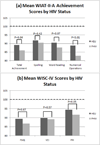Discordance of cognitive and academic achievement outcomes in youth with perinatal HIV exposure
- PMID: 25361033
- PMCID: PMC4217131
- DOI: 10.1097/INF.0000000000000314
Discordance of cognitive and academic achievement outcomes in youth with perinatal HIV exposure
Abstract
Background: To evaluate achievement in youth with perinatally acquired HIV (PHIV) compared with HIV-exposed uninfected peers (HEU) and to examine differential effects of HIV on cognition-achievement concordance.
Methods: Cognition and achievement were assessed using standardized measures. Intelligence quotient-derived predicted achievement scores were subtracted from observed achievement scores to calculate discrepancy values. Linear regression models were used to compare achievement discrepancies between PHIV and HEU, adjusting for demographic covariates.
Participants: 295 PHIV and 167 HEU youth; 71% black, 48% male, mean age 13.1 and 11.3 years, respectively. PHIV youth were relatively healthy (mean CD4%, 32%; viral load ≤400 copies/mL, 72%). PHIV and HEU youth had cognitive and achievement scores significantly below population norm means (P < 0.001), but did not differ in cognition (mean full scale IQ = 86.7 vs. 89.4, respectively). In unadjusted models, HEU outperformed PHIV youth on total achievement (mean = 89.2 vs. 86.0, P = 0.04) and numerical operations (mean = 88.8 vs. 82.9, P < 0.001); no differences remained after adjustment. Mean observed-predicted achievement discrepancies reflected "underachievement". History of encephalopathy predicted poorer achievement (P = 0.039) and greater underachievement, even after adjustment. PHIV showed greater underachievement than HEU for numerical operations (P < 0.001) and total achievement (P = 0.03), but these differences did not persist in adjusted models.
Conclusions: Both PHIV and HEU youth demonstrated lower achievement than normative samples and underachieved relative to predicted achievement scores. Observed-predicted achievement discrepancies were associated with prior encephalopathy, older age and other non-HIV factors. PHIV youth with prior encephalopathy had significantly lower achievement and greater underachievement compared with PHIV without encephalopathy and HEU youth, even in adjusted models.
Figures

Similar articles
-
Neurodevelopment of HIV-Exposed Uninfected Infants Born to Women With Perinatally Acquired HIV in the United States.J Acquir Immune Defic Syndr. 2020 Jun 1;84(2):213-219. doi: 10.1097/QAI.0000000000002318. J Acquir Immune Defic Syndr. 2020. PMID: 32032301 Free PMC article.
-
Executive Functioning in Children and Adolescents With Perinatal HIV Infection and Perinatal HIV Exposure.J Pediatric Infect Dis Soc. 2016 Dec;5(suppl 1):S15-S23. doi: 10.1093/jpids/piw049. J Pediatric Infect Dis Soc. 2016. PMID: 27856672 Free PMC article.
-
Prospective memory in youth with perinatally-acquired HIV infection.Child Neuropsychol. 2018 Oct;24(7):938-958. doi: 10.1080/09297049.2017.1360854. Epub 2017 Aug 7. Child Neuropsychol. 2018. PMID: 28782457 Free PMC article.
-
Understanding the mental health of youth living with perinatal HIV infection: lessons learned and current challenges.J Int AIDS Soc. 2013 Jun 18;16(1):18593. doi: 10.7448/IAS.16.1.18593. J Int AIDS Soc. 2013. PMID: 23782478 Free PMC article. Review.
-
Neurodevelopment in Young Children Born to HIV-Infected Mothers: A Meta-analysis.Pediatrics. 2018 Feb;141(2):e20172888. doi: 10.1542/peds.2017-2888. Pediatrics. 2018. PMID: 29374109 Free PMC article.
Cited by
-
Propelling the Pediatric HIV Therapeutic Agenda With Science, Innovation, and Collaboration.J Acquir Immune Defic Syndr. 2018 Aug 15;78 Suppl 1(1):S32-S39. doi: 10.1097/QAI.0000000000001747. J Acquir Immune Defic Syndr. 2018. PMID: 29994918 Free PMC article.
-
Perinatal HIV Status and Executive Function During School-Age and Adolescence: A Comparative Study of Long-Term Cognitive Capacity Among Children From a High HIV Prevalence Setting.Medicine (Baltimore). 2016 Apr;95(17):e3438. doi: 10.1097/MD.0000000000003438. Medicine (Baltimore). 2016. PMID: 27124032 Free PMC article.
-
Mental health and adaptive functioning among school-aged children living with HIV in Zambia.Front Psychiatry. 2022 Sep 7;13:922944. doi: 10.3389/fpsyt.2022.922944. eCollection 2022. Front Psychiatry. 2022. PMID: 36159920 Free PMC article.
-
Contributions of Disease Severity, Psychosocial Factors, and Cognition to Behavioral Functioning in US Youth Perinatally Exposed to HIV.AIDS Behav. 2017 Sep;21(9):2703-2715. doi: 10.1007/s10461-016-1508-5. AIDS Behav. 2017. PMID: 27475941 Free PMC article.
-
Cognitive and academic performance of rural Zambian youth exposed to HIV.AIDS Care. 2023 Mar;35(3):453-460. doi: 10.1080/09540121.2022.2050175. Epub 2022 May 4. AIDS Care. 2023. PMID: 35509240 Free PMC article.
References
-
- Armstrong FD. Neurodevelopment and chronic illness: Mechanisms of disease and treatment. Ment Retard Dev Disabil Res Rev. 2006;12:168–173. - PubMed
-
- Willen EJ. Neurocognitive outcomes in pediatric HIV. Ment Retard Dev Disabil Res Rev. 2006;12:223–228. - PubMed
-
- Shanbhag MC, Rutstein RM, Zaoutis T, et al. Neurocognitive functioning in pediatric human immunodeficiency virus infection: Effects of combined therapy. Arch Pediatr Adolesc Med. 2005 Jul;159:651–657. - PubMed
-
- Wolters PM, Brouwers P. Neurobehavioral function and assessment in children with HIV. In: Zeichner S, Read J, editors. Textbook of Pediatric HIV Care. Cambridge: Cambridge University Press; 2005. pp. 269–284.
Publication types
MeSH terms
Grants and funding
LinkOut - more resources
Full Text Sources
Other Literature Sources
Medical
Research Materials

